
Over the years, I’ve performed thousands of laser and lens-based refractive procedures. Like some of my colleagues, I initially approached phakic IOLs as a niche solution that was ideal for patients with high myopia, thin corneas, and dry eye concerns. Over time, however, my perception of the procedure began to shift, and I started to expand my indications to include those with mid to low myopia as well. This change came naturally as my practice went back and tracked not just patients’ visual outcomes but also their overall satisfaction, referral behavior, visit frequency, and marketing cost per case over a 5-year period to represent the entire clinical and economic lifecycle of a refractive surgery patient. We quickly found that our patients who had lens-based correction, particularly phakic IOLs, were more satisfied, referred more friends and family (and for a longer duration), and required less chair time and practice resources compared to our patients who underwent laser vision correction (see infographic).

Since we’ve evolved our practice model, we now perform approximately 2,000 lens-based procedures per year. This includes about 500 EVO ICL procedures (STAAR Surgical), 500 refractive lens exchange procedures, and 1,000 refractive cataract surgery procedures. Our laser vision correction volume is around 150 cases annually.
The longevity of patient referrals after lens-based refractive surgery has proved to be a pivotal part of our business strategy. Thanks to our ICL patients, who have become loyal long-term ambassadors for our practice, we have seen measurable downstream value.
Some refractive surgery practices assume that patients who undergo laser vision correction are easier to attract and manage due to lower upfront costs and simpler logistics. Our practice’s experience tells a different story. In Germany, a highly competitive market for refractive surgery, online advertising (i.e., search engines and social media) dominates marketing efforts.
The average lead cost per laser vision correction patient is €300 ($352), compared to €150 ($176) for lens-based refractive surgery.
When referrals are factored in, the effective cost per case was €150 for laser vision correction and €25 ($30) for lens-based correction. The significant differential adds up quickly, especially when clinic savings are also considered. From pre- to post-operative care, patients electing a lens-based refractive surgery procedure required an average of six visits compared to eight for those electing laser vision correction. In a busy, multi-location practice like ours, the two additional visits per patient translate into a substantial cost not only in clinic time, but also in administrative support and patient flow.
More importantly, our lens-based refractive surgery patients were more content overall after surgery, requiring fewer touchpoints to reach satisfaction. This made our team’s work easier and helped preserve morale, a critical but often underappreciated factor in practice sustainability.
Matching the right patient to the right procedure
Not every patient is suitable for phakic IOLs. We therefore rely on a refined screening process to improve the chance for optimized vision and patient satisfaction, even for those who ultimately underwent laser vision correction due to contraindications for a lens-based procedure. We use ICL as our first option for all myopic cases and laser vision correction for myopia under -6.00 D if explicitly requested by the patient, and laser vision correction is our first choice for eyes with predominant astigmatism as well as for up to 3.00 D of hyperopia. For presbyopia and higher hyperopia, we opt for refractive lens exchange. Additionally, the quality of the cornea was a major factor in determining the rate of recommendation.
We observed that patients who were less satisfied with LVC often had one or more of the following characteristics:
Pupil size greater than 7.5 mm
Corneal power less than 39.00 D
Endothelial cell count less than 2,500 cells/mm²
Contact lens intolerance
Patients who were less satisfied with phakic IOL outcomes often had one or more of the following characteristics:
Endothelial cell count less than 2,300 cells/mm²
Total higher-order aberrations above 300 µm
Centralized higher-order aberrations above 200 µm
Not only has refining patient selection improved post-operative outcomes, it has strengthened our clinic’s reputation. Patients increasingly see us not just as a place to get LASIK, but as a trusted partner in refractive vision care.
Challenge your assumptions
A one-size-fits-all solution in refractive surgery does not exist; however, I believe we need to challenge our assumptions, especially the idea that laser vision correction should automatically be the first-line approach in a refractive surgery clinic. Our clinical experience shows the value of an ICL-first strategy backed by data and patient-centered thinking, and has led to the following advantages:
Improved clinical outcomes and patient satisfaction Lower patient acquisition costs
Reduced clinic staff and resource burdens
Long-term practice growth through word-of-mouth marketing
For those considering a similar shift, my advice is to start tracking the right metrics. Go beyond Uncorrected Visual Acuity (UCVA) and monitor patient satisfaction, referral rates, visit counts, and marketing costs. The numbers will guide you along the journey. Modest changes rooted in evidence can lead to transformational results and ultimately a stronger, more resilient practice.
